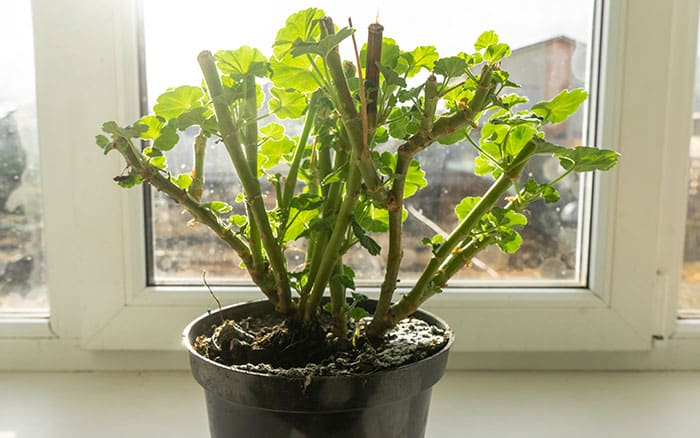Once you’ve put your plants to bed for winter, it’s likely you’re waiting patiently for the moment to get them back out and growing again. Looking forward to bursting blooms in spring and summer. Here’s a guide to reviving overwintered plants.
To bring your plants out of their dormant period, it’s ideal to have a rough idea of when the last risk of frost is so you can work out the best time to bring out the specific plants to get them ready for the season ahead.
There are so many benefits to overwintering plants. First, it’ll save you loads of money as you can grow the same plants year after year. But it’ll also keep some much-loved plants in your garden and your family for years to come.
Geraniums
Before you get started, work out when the last expected frost is and count back approximately 6-8 weeks. This is when you should begin the process of reviving your overwintered geraniums.
The first step is to cut back any dead, diseased, or damaged leaves so just the healthy growth is left.
Move the plant to a warm spot indoors with indirect sunlight. Give it a good water and feed with a well-balanced liquid fertiliser to kick-start new growth.
Then, rather than bringing them straight outdoors, harden the plants off, to acclimatise to outdoor conditions. Gradually expose them to outdoor elements. Do this by positioning them in a sheltered spot outdoors during the day and taking them back inside overnight. Once the risk of frost has passed, the geraniums can then be kept outdoors for summer and autumn. If they are going to be planted out into the ground, do this around May. When planting out, feed them with a slow-release fertiliser that will give them essential nutrients to grow.

Dahlias
There’s a popular tradition of planting peas and potatoes on St Patrick’s Day in the US and the UK. This tradition is to do with the timing of the crops and how to make the most of them. Mid-March is a great time for planting peas and potatoes because the soil is the optimum temperature for planting, and the weather is just right. Of course, this depends on the temperamental UK weather.
Although it may not be a tradition, St Patrick’s Day also the best time to plant dahlia tubers. Because to have the best dahlias, you’ll need to get the timing right.
The tubers are where the energy and nutrients for the plant are stored, so once planted there is enough energy to go towards the plant thriving. These tubers are round or oblong, beige, or brown in colour, and they kind of feel like potatoes. If they feel and look like this, they’re ok to be replanted for another year. However, if they’re soft, squidgy, or have any liquid seeping from them, it’s best to compost them and get hold of some new ones.
There are two methods from bringing dahlias back from their dormancy. The method you use will depend on how you overwintered the tubers.
Firstly, if you planted the tubers in a pot and kept them indoors, these can be brought into a bright, warm spot and watered. In less than a month, you should see some growth. It may be tempting to water them but try not to overwater before seeing growth. Instead, the energy and nutrients from the tuber should be enough to get it going.
On the other hand, if you stored loose dahlias over winter, these can be planted up. Fill a container with good quality peat-free compost and plant the tuber about 3cm below the surface, with the stem facing upwards. Ensure the tuber is firmed into place which will allow water to get to it effectively.
Position the container in a bright, warm spot and water well. Again, in less than a month you should see growth.
You’ll need patience waiting for it to sprout, but once it has, it’ll grow nice and quickly. Once the plant has grown to 7-15cm tall, they can be moved into a cooler spot to continue growing.
Growing them in a cooler spot that’s between 16-18 degrees Celsius will stop the dahlias from growing too fast. If they grow too fast, the stems may grow quickly but be weak and unable to support the flowers.
Pinching dahlias
When the dahlia reaches before 20-30cm, they should be pinched. Pinching concentrates the energy of the plant to producing stronger branches, reduces the likelihood of stretching and encourages more flowers.
Do this by identifying the nodes, which is where the leaves grow from the stem. Look out for the third node up the plant from the base of the stem and pinch the growth from the centre of that set of leaves using your fingers. This will encourage new growth lower down the plant for denser, fuller growth.

Fuchsias
Bringing fuchsias out of their dormant hibernation should happen about a month before the last frost is due.
The first step is to reposition them in a warm, sunny spot and give the plant a trim by pruning back the branches by half. This will encourage new, healthy growth. At this time, normal watering can resume. However, be sure not to overwater as this can lead to root rot.
When the risk of frost has passed, the fuchsia can be moved to a shaded, sheltered spot outdoors during the day and brought back indoors over night to acclimatise it. Then, the plant can be permanently kept outside over summer or planted out.


Leave A Comment